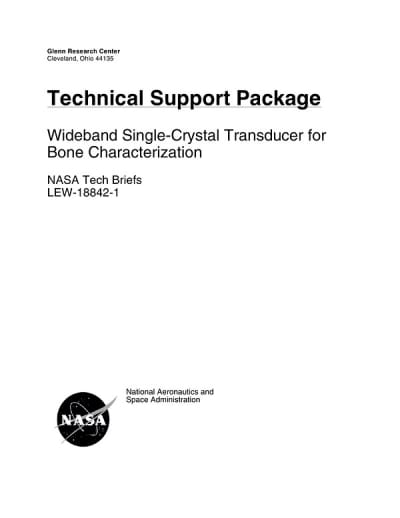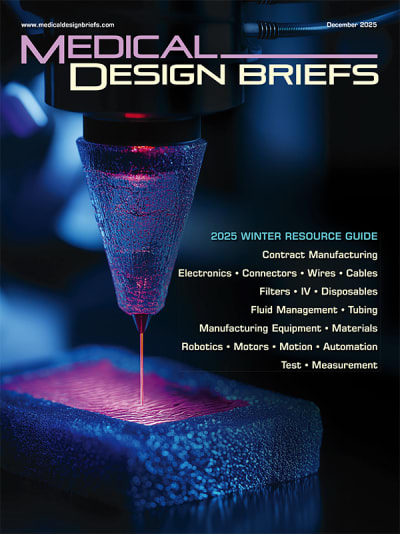The microgravity conditions of space travel result in unique physiological demands on the human body. In particular, the absence of the continual mechanical stresses on the skeletal system that are present on Earth cause the bones to decalcify. Trabecular structure decreases in thickness and increases in spacing, resulting in decreased bone strength and increased risk of injury. Thus, monitoring bone health is a high priority for long-term space travel. A single probe covering all frequency bands of interest would be ideal for such measurements, and this would also minimize storage space and eliminate the complexity of integrating multiple probes.
This invention is an ultrasound transducer for the structural characterization of bone. Such characterization measures features of reflected and transmitted ultrasound signals, and correlates these signals with bone structure metrics such as bone mineral density, trabecular spacing, and thickness, etc. The techniques used to determine these various metrics require measurements over a broad range of ultrasound frequencies, and therefore, complete characterization requires the use of several narrowband transducers.
This is a single transducer capable of making these measurements in all the required frequency bands. The device achieves this capability through a unique combination of a broadband piezoelectric material; a design incorporating multiple resonator sizes with distinct, overlapping frequency spectra; and a micromachining process for producing the multiple- resonator pattern with common electrode surfaces between the resonators.
This device consists of a pattern of resonator bars with common electrodes that is wrapped around a central mandrel such that the radiating faces of the resonators are coplanar and can be simultaneously applied to the sample to be measured. The device operates as both a source and receiver of acoustic energy. It is operated by connection to an electronic system capable of both providing an excitation signal to the transducer and amplifying the signal received from the transducer. The excitation signal may be either a wide-bandwidth signal to excite the transducer across its entire operational spectrum, or a narrow-bandwidth signal optimized for a particular measurement technique. The transducer face is applied to the skin covering the bone to be characterized, and may be operated in through-transmission mode using two transducers, or in pulse-echo mode.
The transducer is a unique combination of material, design, and fabrication technique. It is based on single-crystal lead magnesium niobate lead titanate (PMN-PT) piezoelectric material. As compared to the commonly used piezoceramics, this piezocrystal has superior piezoelectric and elastic properties, which results in devices with superior bandwidth, source level, and power requirements. This design necessitates a single resonant frequency. However, by operating in a transverse length-extensional mode, with the electric field applied orthogonally to the extensional direction, resonators of different sizes can share common electrodes, resulting in a multiply- resonant structure. With carefully sized resonators, and the superior bandwidth of piezocrystal, the resonances can be made to overlap to form a smooth, wide-bandwidth characteristic.
This work was done by Yu Liang and Kevin Snook of TRS Technologies, Inc. for Glenn Research Center.
Inquiries concerning rights for the commercial use of this invention should be addressed to
NASA Glenn Research Center
Innovative Partnerships Office
Attn: Steven Fedor
Mail Stop 4–8
21000 Brookpark Road
Cleveland
Ohio 44135.
LEW-18842-1
This Brief includes a Technical Support Package (TSP).

Wideband Single-Crystal Transducer for Bone Characterization
(reference LEW-18842-1) is currently available for download from the TSP library.
Don't have an account?
Overview
The document outlines the development and capabilities of a Wideband Single-Crystal Transducer for Bone Characterization, created by NASA's Glenn Research Center. This innovative ultrasound transducer is designed to address the challenges of monitoring bone health, particularly in the context of microgravity conditions experienced during space travel. In such environments, the absence of mechanical stress leads to bone decalcification, decreased trabecular structure, and increased risk of injury, making effective monitoring essential.
The transducer operates by measuring reflected and transmitted ultrasound signals to characterize bone structure metrics, including bone mineral density (BMD), trabecular spacing, and thickness. Traditional methods often require multiple narrowband transducers to cover the necessary frequency range, complicating the measurement process. In contrast, this new device utilizes a single transducer capable of operating across a broad spectrum of frequencies, thus simplifying the measurement process and minimizing the size, weight, and power consumption—critical factors for space applications.
The technical design of the transducer involves a unique combination of broadband piezoelectric materials and a micromachining process that allows for the creation of multiple resonator sizes with overlapping frequency spectra. This design enables the simultaneous application of the transducer to the bone surface, facilitating accurate and comprehensive measurements. The device can operate in both through-transmission and pulse-echo modes, depending on the specific measurement requirements.
The document also highlights the potential market impact of this technology, particularly in the fields of osteoporosis diagnosis and treatment. With an aging population and increasing prevalence of osteoporosis, the demand for effective diagnostic tools is expected to grow. The market for low-intensity pulsed ultrasound stimulators was approximately $250 million in 2006, indicating a significant opportunity for commercial ultrasound bone diagnostic tools.
In summary, the Wideband Single-Crystal Transducer represents a significant advancement in bone health monitoring technology, with applications that extend beyond space travel to broader medical diagnostics. Its innovative design and operational capabilities position it as a promising tool for improving bone health assessment and treatment strategies. For further information, the document provides contact details for the Glenn Technology Transfer Office for those interested in exploring this technology further.



